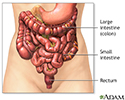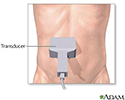Gas - flatulence
Flatulence; Flatus
Gas is air in the intestine that is passed through the rectum. Air that moves from the digestive tract through the mouth is called belching .
Belching
Belching is the act of bringing up air from the stomach.

Gas is also called flatus or flatulence.
Considerations
Gas is normally formed in the intestines as your body digests food.
Gas can make you feel bloated. It can cause crampy or colicky pains in your belly.
Causes
Gas can be caused by certain foods you eat. You may have gas if you:
- Eat foods that are hard to digest, such as fiber. Sometimes, adding more fiber into your diet can cause temporary gas. Your body may adjust and stop producing gas over time.
-
Eat or drink something your body cannot tolerate. For example, some people have
lactose intolerance
and cannot eat or drink dairy products.
Lactose intolerance
Lactose is a type of sugar found in milk and other dairy products. An enzyme called lactase is needed by the body to digest lactose. Lactose intoler...
 ImageRead Article Now Book Mark Article
ImageRead Article Now Book Mark Article
Other common causes of gas are:
- Antibiotics
-
Irritable bowel syndrome
Irritable bowel syndrome
Irritable bowel syndrome (IBS) is a disorder that leads to abdominal pain and bowel changes. IBS is not the same as inflammatory bowel disease (IBD)...
 ImageRead Article Now Book Mark Article
ImageRead Article Now Book Mark Article -
Inability to absorb nutrients properly (
malabsorption
)
Malabsorption
Malabsorption involves problems with the body's ability to take in nutrients from food.
 ImageRead Article Now Book Mark Article
ImageRead Article Now Book Mark Article - Inability to digest nutrients properly (maldigestion)
- Swallowing air while eating
Home Care
The following tips may help you prevent gas:
- Chew your food more thoroughly.
- Do not eat beans or cabbage.
- Avoid foods high in poorly digestible carbohydrates. These are called FODMAPs and include fructose (fruit sugar).
- Avoid lactose.
- Do not drink carbonated drinks.
- Do not chew gum.
- Eat more slowly.
- Relax while you eat.
- Walk for 10 to 15 minutes after eating.
When to Contact a Medical Professional
Call your health care provider if you have:
- Gas and other symptoms such as stomach pain, rectal pain, heartburn, nausea, vomiting, diarrhea, constipation, fever, or weight loss
- Oily, foul-smelling, or bloody stools
What to Expect at Your Office Visit
Your provider will perform a physical exam and ask questions about your medical history and symptoms, such as:
- What foods do you commonly eat?
- Has your diet changed recently?
-
Have you increased the
fiber
in your diet?
Fiber
Fiber is a substance found in plants. Dietary fiber, which is the type of fiber you can eat, is found in fruits, vegetables, and grains. It is an i...
 ImageRead Article Now Book Mark Article
ImageRead Article Now Book Mark Article - How fast do you eat, chew, and swallow?
- Would you say that your gas is mild or severe?
- Does your gas seem to be related to eating milk products or other specific foods?
- What seems to make your gas better?
- What medicines do you take?
-
Do you have other symptoms, like abdominal pain, diarrhea,
early satiety
(premature fullness after meals),
bloating
, or
weight loss
?
Early satiety
Satiety is the satisfied feeling of being full after eating. Early satiety is feeling full sooner than normal or after eating less than usual....
 ImageRead Article Now Book Mark Article
ImageRead Article Now Book Mark ArticleBloating
Abdominal bloating is a condition in which the belly (abdomen) feels full and tight. Your belly may look swollen (distended).
 ImageRead Article Now Book Mark Article
ImageRead Article Now Book Mark ArticleWeight loss
Unexplained weight loss is a decrease in body weight, when you did not try to lose the weight on your own. Many people gain and lose weight. Uninten...
Read Article Now Book Mark Article
Tests that may be done include:
-
Abdominal CT scan
Abdominal CT scan
An abdominal CT scan is an imaging method. This test uses x-rays to create cross-sectional pictures of the belly area. CT stands for computed tomog...
 ImageRead Article Now Book Mark Article
ImageRead Article Now Book Mark Article -
Abdominal ultrasound
Abdominal ultrasound
Abdominal ultrasound is a type of imaging test. It is used to look at organs in the abdomen, including the liver, gallbladder, spleen, pancreas, and...
 ImageRead Article Now Book Mark Article
ImageRead Article Now Book Mark Article -
Barium enema x-ray
Barium enema x-ray
Barium enema is a special x-ray of the large intestine, which includes the colon and rectum.
 ImageRead Article Now Book Mark Article
ImageRead Article Now Book Mark Article -
Barium swallow x-ray
Barium swallow x-ray
An upper GI and small bowel series is a set of x-rays taken to examine the esophagus, stomach, and small intestine. Barium enema is a related test....
 ImageRead Article Now Book Mark Article
ImageRead Article Now Book Mark Article -
Blood work such as
CBC
or
blood differential
CBC
A complete blood count (CBC) test measures the following:The number of red blood cells (RBC count)The number of white blood cells (WBC count)The tota...
 ImageRead Article Now Book Mark Article
ImageRead Article Now Book Mark ArticleBlood differential
The blood differential test measures the percentage of each type of white blood cell (WBC) that you have in your blood. It also reveals if there are...
 ImageRead Article Now Book Mark Article
ImageRead Article Now Book Mark Article -
Sigmoidoscopy
Sigmoidoscopy
Sigmoidoscopy is a procedure used to see inside the sigmoid colon and rectum. The sigmoid colon is the area of the large intestine nearest to the re...
 ImageRead Article Now Book Mark Article
ImageRead Article Now Book Mark Article -
Upper endoscopy (EGD)
Upper endoscopy (EGD)
Esophagogastroduodenoscopy (EGD) is a test to examine the lining of the esophagus, stomach, and first part of the small intestine.
 ImageRead Article Now Book Mark Article
ImageRead Article Now Book Mark Article - Breath test
References
Azpiroz F. Intestinal gas. In: Feldman M, Friedman LS, Brandt LJ, eds. Sleisenger and Fordtran's Gastrointestinal and Liver Disease . 10th ed. Philadelphia, PA: Elsevier Saunders; 2016:chap 17.
McQuaid KR. Approach to the patient with gastrointestinal disease. In: Goldman L, Schafer AI, eds. Goldman's Cecil Medicine . 25th ed. Philadelphia, PA: Elsevier Saunders; 2016:chap 132.
Wilkins T, Pepitone C, Alex B, Schade RR. Diagnosis and management of IBS in adults. Am Fam Physician . 2012;86(5):419-426. PMID: 22963061 www.ncbi.nlm.nih.gov/pubmed/22963061 .
-
Intestinal gas - illustration
Gas is formed in the intestines by the action of bacteria as food is being digested. Gas is also called flatus or flatulence, and is passed through the intestine and out the body through the rectum.
Intestinal gas
illustration
-
Abdominal ultrasound - illustration
The test is done in the ultrasound or radiology department. A conducting paste is applied to your abdomen while you are lying down. The transducer (a hand-held instrument) is then moved over your abdomen.
Abdominal ultrasound
illustration
-
Intestinal gas - illustration
Gas is formed in the intestines by the action of bacteria as food is being digested. Gas is also called flatus or flatulence, and is passed through the intestine and out the body through the rectum.
Intestinal gas
illustration
-
Abdominal ultrasound - illustration
The test is done in the ultrasound or radiology department. A conducting paste is applied to your abdomen while you are lying down. The transducer (a hand-held instrument) is then moved over your abdomen.
Abdominal ultrasound
illustration
Review Date: 5/21/2016
Reviewed By: Linda J. Vorvick, MD, Medical Director and Director of Didactic Curriculum, MEDEX Northwest Division of Physician Assistant Studies, Department of Family Medicine, UW Medicine, School of Medicine, University of Washington, Seattle, WA. Also reviewed by David Zieve, MD, MHA, Isla Ogilvie, PhD, and the A.D.A.M. Editorial team.


